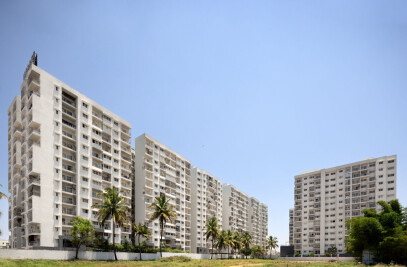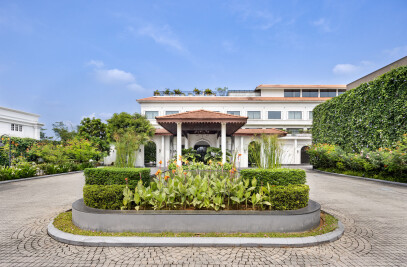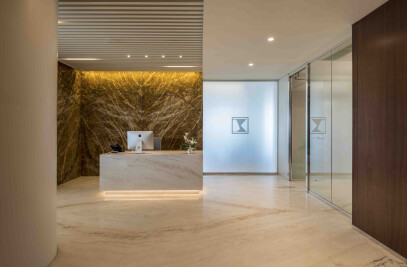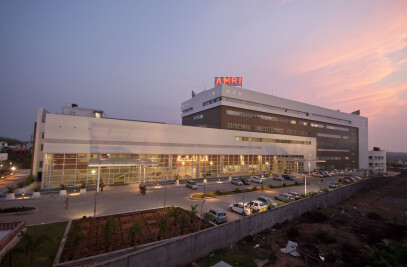Today, business spaces are no longer mere production facilities, but places where network and innovation cultures are forged. The quality of these community environments is fast becoming the key factor in deciding what makes for a first-rate facility. Business spaces for knowledge industries, in particular, are characterized by the quality of the communal environment for business and social networking – this quality is increasingly becoming the differentiating factor between competing developers. The planning and design of the community environment inside and outside the buildings, hence, gains great significance.
The successful business space of tomorrow will be an environment, a place where knowledge talents are not merely workers, but also social and cultural beings.
Victor is a multi-tenanted building that is a part of a 9-acre master plan in the ITPB SEZ. As the third addition to the campus, the tower brings to fruition the original intent of the strategic planning – that of integrating the internal and external public spaces between all the three buildings in the master plan to create a pedestrian-friendly micro-environment, to facilitate interaction among users and developing a community-centric facility. The notion of sustainability is integral to the project design.

Planning Considerations:
The total built up area of the building is 6,20,000 sq.ft. It consists of two basements, a ground level, and thirteen levels of office space, with 45,000 sq.ft of office space on each floor. The form of the building is aligned along the East-West axis, maximising northlighting and reducing direct solar glare on the facades. The service cores of the building have been placed along the central axis, opening outwards – this ensures natural light and ventilation in the staircases and lift lobbies, and natural light in the mechanically ventilated toilets.
The building alignment and orientation enables self-shading during mornings and evenings; the abutting reception and cafeteria are shaded by the tower, even during times of peak solar glare.

The urban park next to the Victor tower becomes the central point of interaction within the campus; the green cover also helps lower ambient temperature. The ground floor of the tower provides thoroughfare pedestrian access, allowing for greater social interaction
Vehicular traffic has been relegated to the periphery of the site, facilitating unimpeded pedestrian traffic between the towers. Staggered grass-and-granite bands form the primary landscape vocabulary, and determine the building edge; the reception of the tower uses bands of dark granite for flooring and furniture, as a continuation of the lighter granite bands in the landscaping.
At the ground floor, the material palette of the building juxtaposes red sandstone with plastic finish paint and glass. The cafeteria is ringed by sandstone pillars, and so is the reception; the contrast of materiality as well as form between these spaces, and the vocabulary of the tower, helps the social zones stand out. The visual vocabulary of the Victor tower references that of its neighbouring development, Aviator, but retains its individual identity through use of a different material and colour palette.
Structural Configuration:
The column grid – at 8.5 by 11 meters – has been designed to optimize the use of construction material, utilizing a flat-slab technique and reducing the size of the columns to 1X1 m. The typical floorplate of the Victor tower places the service cores along the central axis, ensuring natural light and ventilation in these spaces. The recession of the building envelope along the Eastern and Western edges ensures minimal solar glare in these typically susceptible parts.
The column grid has been designed to provide maximum efficiency at both the parking as well as the office levels, achieving upto 87% on the upper levels. With daylight penetration of upto 12-15 meters, the floorplates are uniformly lit from all sides, allowing for flexibility of function within. The lift lobby of the tower, like all other service cores of the building, is amply lit by natural means
Climatic Controls and Façade Design:
Apart from the planning considerations, the use of roofing materials with a reflectance index of ~78 negates the heat island effect, and reduces the net heat gain of the building. 3 floor plate modules stacked strategically extend onto the arrangement of panels and voids in the facade, creating a staggered, visually intricate appearance.
Solar glare at peak hours is diffused through use of performance glass of low U-value. With blue-green laminated glass and orange fritt glass, the glare inside the office space is further reduced to an ambient glow. The facade achieves 35-37% glazing; with a 24% light transmission, a solar factor of 0.2, and a U-value of 1.8. The panels have been arranged modularly, to maintain this ratio across all internal spaces and ensure consistent saleability.
The facade of the building utilizes staggered panels of coloured and clear performance glass, stacked between concrete bands indicating levels within the tower. The panels are 1050 mm wide each, factored from the typical width of raw glass sheets available to ensure minimal wastage. Paired with performance glass, the optimal wall-window ratio ensures optimal diffused daylighting inside the building with minimal heat gain.
Other salient features:
Z-Profile louvers along the staircase shaft screen rainwater without affecting ingress of light. Treated water from the STP units is used to run cooling towers as well as for maintenance of the landscape. The use of grass bands along with granite ensure percolation of surface run-off to the water table. On-site water recycling and harvesting systems have increased the availability of potable water by 20%.
Topsoil conservation and dust minimization were prioritized during the construction process.
Conclusion:
The primary challenge faced in this project was that of maintaining the original intent and strategies of the master plan, without compromising on value addition as per current trends. The elevation treatment was also critical, as it had to carry forward the design vocabulary of the adjacent buildings on the master plan, yet stand out as a unique development. The outcome is a building that strikes a balance between learning from the old and experimentation with the new.


































